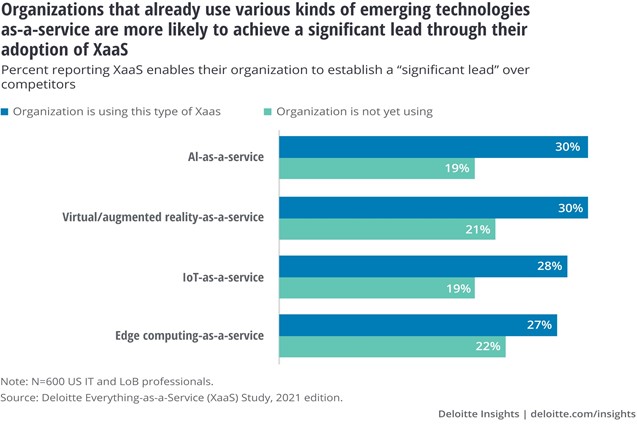The Utilization of Emerging Technologies as a Service

The utilization of emerging technologies a service provides a competitive advantage to XaaS (Anything as a Service) adopters who leverage service-based IT for access to state-of-the-art features and technologies.
As XaaS becomes increasingly prevalent, the question arises: how will adopters maintain and establish a competitive edge? One possible answer lies in the realm of emerging technologies.
Over the last decade, organizations across various sectors have sought greater control over their enterprise IT infrastructure and payment methods. In response, technology providers have transitioned towards a service-oriented model for delivering products, capabilities, and tools (Hardcastle, 2019; Narcisi, 2020; Haranas, 2020).
To investigate the value derived from adopting enterprise IT as-a-service, encompassing motivations, outcomes, and challenges, Deloitte conducted an XaaS study involving 600 IT and line-of-business professionals responsible for service-based IT within large US organizations (Deloitte Insights). Enterprises have enthusiastically embraced the XaaS model, marking a significant shift from traditional, non-service IT to XaaS, with no signs of slowing down (Deloitte Insights, 2018). A staggering 75% of survey respondents confirmed that their organizations already operate more than half of their enterprise IT as-a-service, and 70% have intentions to expand their XaaS investments (Deloitte Insights). In the wake
of disruptive pandemic conditions, organizations are increasingly motivated to adapt and enhance their agility. The crisis has underscored the value of XaaS, prompting executives to accelerate their departure from conventional IT methods.
Beyond streamlining operations for efficiency gains, XaaS adopters are leveraging service-based IT to tap into cutting-edge features and technologies, fostering innovation and enabling the creation of novel processes, products, and business models. Approximately 60% of respondents believe XaaS provides them with a competitive edge, with a quarter of them claiming a “significant lead.” However, given the growing ubiquity of XaaS, adopters may need to work harder to distinguish themselves in the future.
A noteworthy trend is the widespread adoption of software-as-a-service, infrastructure-as-a-service, and platform-as-a-service, with over 80% of respondents confirming their companies’ current usage and almost everyone planning to adopt them within the next two years. Nevertheless, our analysis reveals that organizations expanding their XaaS adoption to encompass advanced or emerging technologies as-a-service may be better positioned for a competitive advantage (Deloitte Insights).
AI-as-a-service and IoT-as-a-service represent substantial and expanding markets, with the AI-as-a-service market forecasted to reach $10.88 billion by 2023 (MarketsandMarkets) and the IoT cloud platform market projected to grow to $11.5 billion by 2025 (MarketsandMarkets). Additionally, intelligent edge computing, a newcomer to XaaS, is rapidly gaining significance, such as in healthcare settings where it supports clinical decision-making by processing patient data near medical devices (GE, BusinessWire). Similarly, in urban environments, edge computing is applied to analyze real-time traffic data and manage traffic signals (Mass Transit).
In conclusion, to establish and maintain a competitive edge through XaaS utilization, organizations should consider several factors. These include defining a clear strategy and roadmap for XaaS adoption, scaling up XaaS usage where underutilized, and leveraging XaaS for innovation, particularly in the context of accessing advanced or emerging technologies as-a-service. While incorporating advanced capabilities as services is a crucial element, it is just one part of the recipe for building and sustaining a competitive advantage with XaaS.